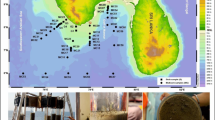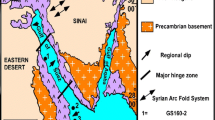Abstract
Algal oncolites are regarded as indicators of shallow-water environment and the size of oncolitic forms is often regarded as an indication of turbulence: the bigger the forms, the stronger the turbulence assumed. Similar environmental significance is also usually ascribed to foraminiferal-algal oncolites. The well-known example of foraminiferal-algal oncolite is Osagia, which was ascertained by Johnson (1946, p. 1103) as being composed of intergrown blue-green algae (Porostromata) and encrusting foraminifera. Osagia is often regarded as environmental index fossil and clear, shallow (0–10 feet), warm, gently agitated water is assumed. There is no doubt that such interpretation is an overgeneralization. This is shown by two other examples of foraminiferal-algal oncolites: soft delicate “tender” oncolites from the Zechstein Limestone (Upper Permian) and Sphaerocodium from the Alpine Triassic.
Access this chapter
Tax calculation will be finalised at checkout
Purchases are for personal use only
Preview
Unable to display preview. Download preview PDF.
Similar content being viewed by others
Bibliography
Angermeier, H.-O., Poschl, A., Schneider, H.-J.: Die Gliederung der Raibler Schichten und die Ausbildung ihrer Liegendgrenze in der “Tirolischen Einheit” der ostlichen Chiemgauer Alpen. Mitt. Bayer. Staatssamml. 3, 83–105 (1963).
Babic, L.: Sphaerocodium or onkoids from the Upper Triassic dolomite of western Yugoslavia? Geol. vj. 23, 11–20 (1970).
Buchanan, H., Streeter, S.S., Gebelein, C.D.: Recent algal-foraminiferal consortia from the Berry Islands, Bahamas. J. Sediment. Petrol., in press (1976).
Flügel, E., Wolf, K.H.: “Sphaerocodien” (Algen) aus dem Devon von Deutschland, Marokko und Australien. N. Jb. Géol. Paléontol. Mh. 1969, 88–103 (1969).
Füchtbauer, H.: Carbonate sedimentation and subsidence in the Zechstein basin (northern Germany). In: Recent Developments in Carbonate Sedimentology in Central Europe. Müller, G., Friedman, G.M. (eds.). Berlin-Heidelberg-New York: Springer 1968, pp. 196–204.
Jerz, H.: Untersuchungen Uber Stoffbestand, Bildungsbedingungen und Paliiogeographie der Raibler Schichten zwischen Lech und Inn (Nordliche Kalkalpen). Géol. Bavarica 56, 3–102 (1966).
Johnson, J.H.: Lime-secreting algae from the Pennsylvanian and Permian of Kansas. Géol. Soc. Am. Bull. 57, 1087–1120 (1946).
Kraus, 0.: Die Raibler Schichten des Drauzuges SUdliche Kalkalpen. Lithofazielle, sedimentpetrographische und paliiogeographische Untersuchungen. Jb. Géol. B.A. 112, 81-152 (1969).
Peryt, T.M., Peryt, D.: Association of sessile tubular foraminifera and schizophytic algae. Géol.Mag. 112, 612–614 (1975).
Rothpletz, A.: tiber Sphaerocodium Bornemanni. eine neue fossile Kalkalge aus den Raibler Schichten der Ostalpen. Bot. Zbl. 52, 9 (1890).
Rothpletz, A.: Fossile Kalkalgen aus den Familien der Codiaceen und der Corallineen. Z. deut. Geol. Ges. 43, 295–322 (1891).
Schüler, G.: Lithofazielle, sedimentologische und paléogeographische Untersuchungen in den Raibler Schichten zwischen Inn und Salzach (Nordliche Kalkalpen). Erlanger Geol. Abh. 71 (1968).
Taylor, J.C.M., Colter, V.S.: Zechstein of the English sector of the southern North Sea. basin. In: Petroleum and the Continental Shelf of North-West Europe, Vol. 1 Geology.
Woodland, A.W. (ed.). London: Applied Science Publishers 1975, pp. 249–263.
Wood, A.: “Sphaerocodium”, a misinterpreted fossil from the Wenlock Limestone. Proc. Géol. Assoc. 59, 9–22 ( 1948).
Wray, J.L.: Upper Devonian calcareous algae from the Canning Basin, Western Australia. Prof. Contr. Colorado School Mines 3 (1967).
Author information
Authors and Affiliations
Editor information
Editors and Affiliations
Rights and permissions
Copyright information
© 1977 Springer-Verlag Berlin · Heidelberg
About this paper
Cite this paper
Peryt, T.M. (1977). Environmental Significance of Foraminiferal-Algal Oncolites. In: Flügel, E. (eds) Fossil Algae. Springer, Berlin, Heidelberg. https://doi.org/10.1007/978-3-642-66516-5_5
Download citation
DOI: https://doi.org/10.1007/978-3-642-66516-5_5
Publisher Name: Springer, Berlin, Heidelberg
Print ISBN: 978-3-642-66518-9
Online ISBN: 978-3-642-66516-5
eBook Packages: Springer Book Archive




